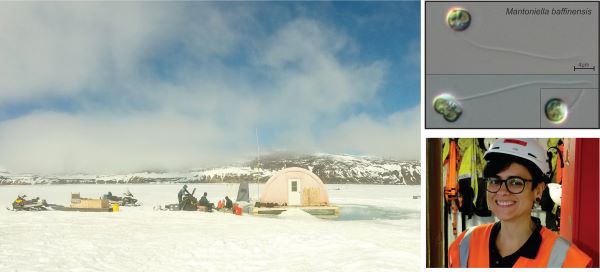Phytoplankton, sentinels of the changing Arctic

Phytoplankton are a fundamental component of Earth’s ecosystem and together with terrestrial plants, the central engine of the carbon cycle. In the ocean, these photosynthetic organisms live in the upper layer that receives the sun light, transforming carbon dioxide into organic compounds that sustain marine life and a large fraction of the human population. Through their growth and decay, they form the foundation of the oceanic food web and constitute one of the major players in sinking atmospheric CO2 in our planet.
Phytoplankton populations undergo periods of rapid growth, known as “blooms”. In high latitudes, phytoplankton blooms re-occur every year. In the Arctic Ocean, phytoplankton blooms occur under and at the ice-edge during the Spring. The phytoplankton spring bloom accounts for > 50% of annual primary production in the Arctic Ocean and is associated with both large energy transfer to higher trophic levels (for example to polar bears) and export of carbon to the bottom of the ocean.
In 2016, Assistant Prof Adriana Lopes joined research team of Green Edge project, a French – Canadian project that investigated the development and role of the of Arctic Spring bloom. During the 2016 field campaign that took place from April to July at an ice camp (Figure) located on landfast sea ice southeast of the Inuit village Qikiqtarjuaq on Baffin Island (above the Arctic circle), an extensive culturing effort was conducted. More than 1000 strains of phytoplankton, covering the different phases of bloom, were isolated and brought into culture. “This is to our knowledge the biggest effort to cultivate Arctic phytoplankton species”– says Asst Prof Adriana.
A subset of 276 strains have been characterized in terms of their morphology and genetics in a recent paper co-authored by Asst Prof Adriana and accepted for publication in the journal Elementa: Science of the Anthropocene. “Strains from 5 different eukaryotic divisions were isolated and several represent yet unknown phytoplankton species” - says Asst Prof Adriana. Among these, a new species of green algae isolated has been recently described as Mantoniella baffinensis (Figure), as a reference to Baffin Bay, where the ice camp was located. These tiny green flagellates only occur only in polar Arctic regions and appear to be associated with sea ice.
The complex links between phytoplankton diversity/production and sea ice dynamics are now beginning to be unraveled. As recently as 2014, it was revelaed that algal blooms could happen under the Arctic sea ice. But climate change has triggered fundamental modifications in the Arctic Ocean; phytoplankton blooms now occur earlier in several parts of the Arctic Ocean and in some parts, the structure of the phytoplankton community is shifting toward smaller species with size similar to M. baffinensis. How this shift towards smaller phytoplankton species will affect the Arctic food web we do not know today but it could have fundamental impact on their key role in the as the bas of the food chain and in the carbon cycle. One reason for the shift towards smaller species is migration of some phytoplankton species found in warmer waters to the Arctic Ocean, where their presence change the composition of the Arctic phytoplanktonic community.
Asst Prof Adriana and co-authors conclude: “We are working against the clock to understand the Arctic ecosystem which is under a rapid and substantial climate driven changes. The strains isolated during Green Edge represent a precious resource to the scientific community as their physiology and adaptations can be analyzed under laboratory conditions and help us to understand and gauge the impacts of the changing Arctic environment on the whole ecosystem”.














/enri-thumbnails/careeropportunities1f0caf1c-a12d-479c-be7c-3c04e085c617.tmb-mega-menu.jpg?Culture=en&sfvrsn=d7261e3b_1)

/cradle-thumbnails/research-capabilities1516d0ba63aa44f0b4ee77a8c05263b2.tmb-mega-menu.jpg?Culture=en&sfvrsn=1bc94f8_1)

7e6fdc03-9018-4d08-9a98-8a21acbc37ba.tmb-mega-menu.jpg?Culture=en&sfvrsn=7deaf618_1)
